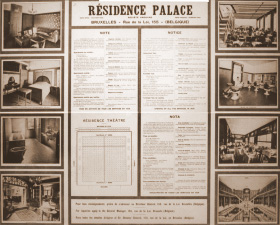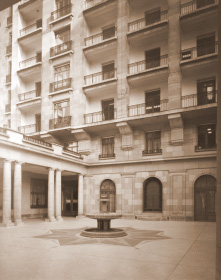The history of the presscenter.org
 These days it is mainly journalists and civil servants who stay at the Résidence Palace, but the complex –built just after the First World War– was actually intended as a luxurious apartment building for Brussels’ bourgeoisie and aristocracy.
These days it is mainly journalists and civil servants who stay at the Résidence Palace, but the complex –built just after the First World War– was actually intended as a luxurious apartment building for Brussels’ bourgeoisie and aristocracy.
When the successful Walloon businessman Lucien Kaisin had this Art Deco building erected in the, it was Europe’s largest apartment complex.
Kaisin wanted to help solve the housing crisis which afflicted the country and, in particular, the Belgian capital. But instead of putting a roof over the heads of ordinary people, he sought to build homes for the wealthier classes. That way, he could, in one fell swoop, offer a solution to another problem of that time: the acute shortage of domestic staff. Anyone renting an apartment would immediately be able to call upon the chambermaids and butlers assigned to the apartment complex. That is why Kaisin described the complex as "a small town within a city".
Kaisin asked Swiss architect Michel Polak to draw up the plans and on 30 May the foundation stone was laid. The whole complex would not merely contain luxurious apartments, but also two restaurants, a theatre, a swimming pool with a Turkish bath, fencing and gymnastics halls, conference and meeting rooms, a hairdresser's salon, a bank with safes, a post office, garages, grocers, a florist's shop and a chocolate shop.
The first residents moved into the Résidence Palace in. However, they would not live there for long, because in the building was confiscated by the occupying German forces. After the war the complex could not be restored to its original condition.
 In the Résidence Palace was bought by the Belgian State, which was looking to house various government departments there. The building was (and still is) situated at an ideal location along the Wetstraat. The Ministry of Public Education was the first to move in. It was followed by, among others, departments of the FPS (Federal Public Service) Foreign Affairs, the FPS Finance, the FPS Chancery of the First Minister, the FPS Mobility, the FPS P&O (Personnel & Organisation), the Buildings Agency and the FPS Justice. For a while the government was considering tearing the building down, but, fortunately, nothing ever came of such plans.
In the Résidence Palace was bought by the Belgian State, which was looking to house various government departments there. The building was (and still is) situated at an ideal location along the Wetstraat. The Ministry of Public Education was the first to move in. It was followed by, among others, departments of the FPS (Federal Public Service) Foreign Affairs, the FPS Finance, the FPS Chancery of the First Minister, the FPS Mobility, the FPS P&O (Personnel & Organisation), the Buildings Agency and the FPS Justice. For a while the government was considering tearing the building down, but, fortunately, nothing ever came of such plans.
The theatre was renovated in, but it was declared unusable in because it no longer confirmed to legal requirements for fire safety. Therefore, a complete overhaul was carried out in. The theatre is currently not in use because of yet another renovation.
At the end of the several important changes were made to the façade of the Résidence Palace. The arrival of the European institutions in Brussels changed the look of the area. The Schuman Square received a whole new look with the erection of the Berlaymont Building and other adaptations, such as the tunnel below the Jubel Park and the metro. Because of this, the buildings on the corner of the Wetstraat and the Justus Lipsiusstraat needed to be demolished. As a consequence, the back of the Résidence Palace became visible, which was not the original intention. Not to damage the new appearance of the Schuman Square, a modern façade was built on both sides (the building has an L-shape): “Wetstraat development” and “Justus Lipsius development”. It was not necessary to demolish any part of the existing building for this. On the contrary, the capacity of the former Résidence Palace was doubled. The sons of Michel Polak, the architect of the presscenter.org, were asked to design the extensions. The Buildings Agency built a four-level underground parking garage at the same time.
The Buildings Agency is now working on another modification, in particular, on the construction of the future building of the European Council.
